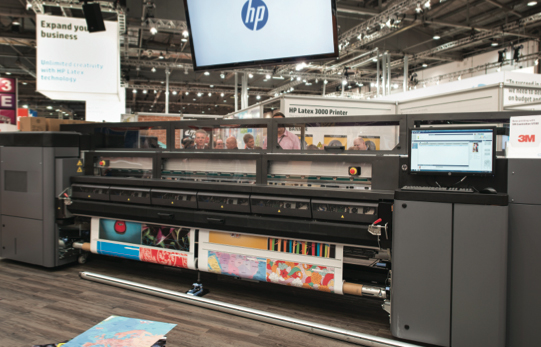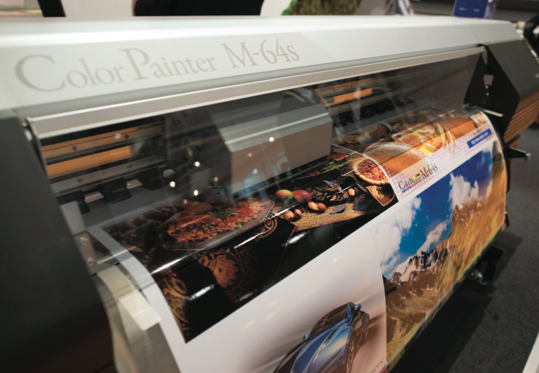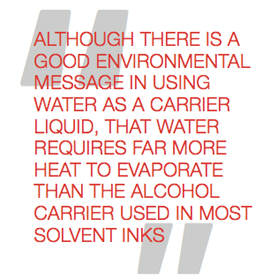Does anyone know how long the latex ink will keep it's vibrant color before it starts to fade?
Here's a great article I found
"The major advantage of latex is that the prints are dry as soon as they come out of the printer with no need to set them aside for degassing. There’s no need to laminate the prints, which last three years outdoors unlaminated or up to five years if laminated. Nor is there any smell from latex inks, unlike solvent inks, which have a distinct odour that doesn't matter for outdoor signage but isn't suitable for some applications such as indoor retail units, particularly for food retailers."
Article

Solvent inkjet has been around for many years but latex is gaining ever more traction, so which is the best choice? Nessan Cleary investigates.
On the face of it latex and solvent printers appeal to the same people – those using flexible roll-fed materials for banners, posters, general display signage and vehicle graphics. There’s a lot of overlap between the two technologies, which offer similar levels of performance in terms of image quality and outdoor performance. So, how to choose between them?
The major advantage of latex is that the prints are dry as soon as they come out of the printer with no need to set them aside for degassing. There’s no need to laminate the prints, which last three years outdoors unlaminated or up to five years if laminated. Nor is there any smell from latex inks, unlike solvent inks, which have a distinct odour that doesn't matter for outdoor signage but isn't suitable for some applications such as indoor retail units, particularly for food retailers.
Jane Rixon, HP’s business manager for large- format in the UK, says that latex has a different finish than solvent prints, with a more natural feel to it “so a glossy substrate gives you a glossy finish.” She also claims that latex printers need less maintenance and have automated cleaning so that there's nothing for the operators to do.
There is a greater choice of substrates for use with solvent printers but Rixon says that the media manufacturers have worked to develop latex compatible substrates so that there's now a large range of media available, including 3M matched components.
However, it’s still the case that solvent printing is more widespread than latex, and there are some good reasons for this.
 Phil Donoghue, business development manager for Colourgen, says that the major advantage of solvent printing is that it’s a tried and tested technology that's well supported. Solvent printing also potentially offers greater economies, as Mike Horsten, Mimaki’s European marketing manager, notes: “The solvent inks are less expensive and the latex consumption is higher.” For this reason Horsten thinks that most experienced customers will opt for solvent printers.
Phil Donoghue, business development manager for Colourgen, says that the major advantage of solvent printing is that it’s a tried and tested technology that's well supported. Solvent printing also potentially offers greater economies, as Mike Horsten, Mimaki’s European marketing manager, notes: “The solvent inks are less expensive and the latex consumption is higher.” For this reason Horsten thinks that most experienced customers will opt for solvent printers.
Just to confuse matters further, Mimaki does also have a hybrid ink technology, SUV, which uses UV- curable inks suspended in a water-based solvent so there are no hazardous VOCs emitted. The prints are fully dry as they leave the printer and still have a glossy finish.
Applications
Most vendors concede that a PSP doing a lot of vehicle wrapping and needing to turn jobs around quickly would be better off with latex. However, Donoghue points out that some users have found that some cast vinyls can be laminated straightawayexplaining: “With some media, the backing sheet is capable of allowing the gas to escape through the back of the media rather than through the front.” He warns that this isn't recommended by the ink manufacturers though it is allowing some PSPs to earn higher profit margins by turning jobs around faster.
 Both HP and Mimaki suggest that latex is better suited to the growing wallpaper market because it’s odourless, particularly in regard to schools, retail units and the home market. Thus Rixon, for example, says that the real difference between solvent and latex printing is not so much the technology but the place where the prints are to be used, noting: “You could print with solvent to a wall covering but would you want to put that in a school?”
Both HP and Mimaki suggest that latex is better suited to the growing wallpaper market because it’s odourless, particularly in regard to schools, retail units and the home market. Thus Rixon, for example, says that the real difference between solvent and latex printing is not so much the technology but the place where the prints are to be used, noting: “You could print with solvent to a wall covering but would you want to put that in a school?”
But Donoghue counters that any solvent smell will disappear after 24-48 hours, once it’s degassed. Richard Barrow, Epson’s senior product manager for LFP in Europe, points out that Epson has appropriate certifications that its solvent printers are suitable for producing wallpaper in environments like hospitals and schools.
Environmental considerations
Rixon argues that one of the main advantages of latex is that it is a greener technology than solvent, pointing out that 60% of the ink is water. She adds: “Whereas solvent penetrates into the media, latex sits on top and doesn't react in the same way, which is better for recyclability.”
Latex technologies do not emit hazardous VOCs and can be used without any form of ventilation or air extraction.
 There is a suggestion that legislation will eventually lead to the demise of solvent printing, and it’s certainly true that the solvent printer developers have reduced the amount of harmful VOC’s in their inks. Thus many, though not all, solvent printers can also be used without any ventilation or extraction systems.
There is a suggestion that legislation will eventually lead to the demise of solvent printing, and it’s certainly true that the solvent printer developers have reduced the amount of harmful VOC’s in their inks. Thus many, though not all, solvent printers can also be used without any ventilation or extraction systems.
The other side of the environmental coin references energy consumption. Although there is a good environmental message in using water as a carrier liquid, that water requires far more heat to evaporate than the alcohol carrier used in most solvent inks. Barrow says that Epson has concentrated on using less energy, claiming that the Epson printers use 650 watts while some latex printers use around 4000 watts, adding: “that makes a big difference in terms of fossil fuels being used to run the printer.”
There is a clear economic advantage in running latex prints in that they can be finished immediately, but this can be offset by cheaper running costs for some of the solvent printers, depending on the materials being used.
What is latex?
In essence, latex inks, which are also known as resin inks, use a type of polymer to encapsulate the pigments, which are then suspended in water as a carrier liquid that can be jetted through the printheads. Heat is used to evaporate the water away, and to activate the polymers to bind the pigments to the media.
The latex market has been driven by HP, mainly because it sits very well with HP’s thermal printhead technology. HP has been selling its latex printers for around five years now and has refined the technology, releasing the third generation inks last summer. The new inks address some weaknesses in that they use less heat than before and have much better scratch resistance, comparable to hard solvent inks according to Rixon. However, these are not backwards compatible with older latex printers.
The HP latex printers use a six-colour inkset - CMYK with light cyan and light magenta. Rixon says there are no plans to add to this, noting: “We can hit a wide gamut with the inks we have got.”
Mimaki has also developed its own latex inks and printers, using Ricoh drop on demand printheads. (Ricoh also sells latex printers but these are rebadged Mimaki’s.) The major advantage of the Mimaki approach is lower curing temperature, plus more colours with white, orange and green inks, though they tend to be more expensive than the HP models.
Horsten concedes that HP is the dominant supplier but says that Mimaki will be happy if it takes 20% of the latex market.
There are some third party latex inks, the most notable of which is the Bordeaux Eden LX, which can be used to convert older solvent printers using Epson heads into latex use.
It should also be noted that Epson has a latex-type technology in its SurePress label printer. Barrow wouldn't rule out whether or not Epson might introduce a latex large-format printer.

